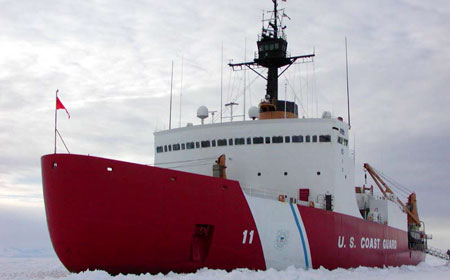
Builder: Lockheed Shipbuilding and Construction Company (Seattle, Washington)Commissioned: February 23, 1977Decommissioned:Length: 399 feetBeam: 83.5 feetDisplacement: 11,000 tonsSpeed: 18 knots (21mph), 3 knots (3.5mph) in 6-foot iceIce Capacity: 21 feet (ramming), 6 feet (continuous)Polar Class
Other Characteristics: The shell plating and associated internal support structure
are fabricated from steel that has especially good low-temperature strength.
The part of the hull designed to break ice is 1.75 inches thick in the bow and stern
sections. The hull shape is designed to maximize icebreaking by efficiently
combining the forces of the ship’s forward motion, the downward pull of gravity
on the bow, and the upward push of the buoyancy of the stern. The curved bow
and heavy weight allow the vessels to force ice edges to break off downward.
History: On February 11, 1981, Polar Sea became the first ship ever
to reach Point Barrow, Alaska in the middle of winter. She is also one of only
three ships that has every completely transited the Arctic Ocean and circumnavigated
North America. In 1985, Polar Sea triggered a diplomatic event by navigating
the Northwest Passage from Greenland to Alaska without authorization from the Canadian
government. The U.S. argued that the Northwest Passage was an international
strait open to shipping and sought only to notify Canada rather than ask for permission.
Canada regarded the move as a breach and disregard of sovereignty. An agreement
was reached two years later that stipulated that the U.S. would ask for permission
before navigating the disputed waters. Polar Sea went out of service
in 2010 due to failure of five of her six main diesel engines. In February 2017,
the refurbishment of Polar Sea was denied, leaving her to be used as a “parts
donor” for Polar Star.
